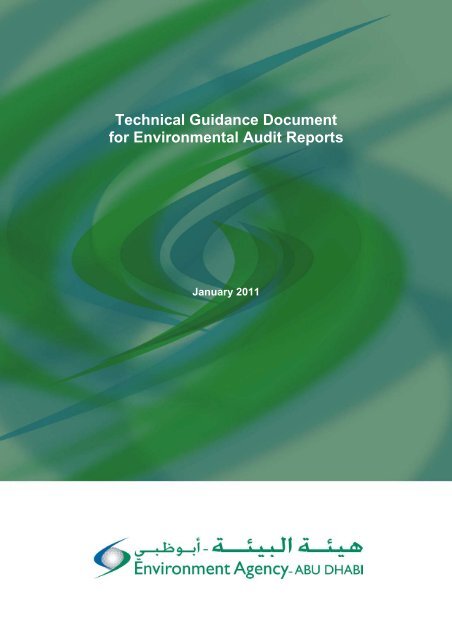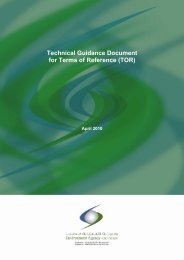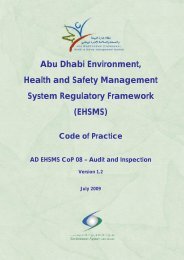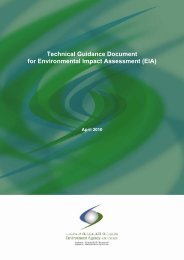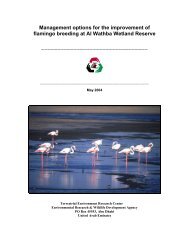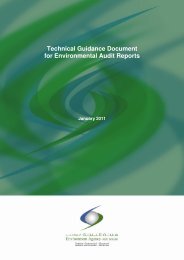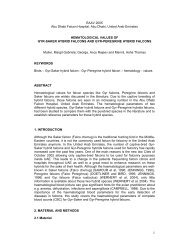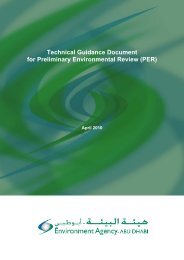Technical Guidance Document for Environmental Audit Reports
Technical Guidance Document for Environmental Audit Reports
Technical Guidance Document for Environmental Audit Reports
You also want an ePaper? Increase the reach of your titles
YUMPU automatically turns print PDFs into web optimized ePapers that Google loves.
<strong>Technical</strong> <strong>Guidance</strong> <strong>Document</strong><br />
<strong>for</strong> <strong>Environmental</strong> <strong>Audit</strong> <strong>Reports</strong><br />
January 2011
<strong>Technical</strong> <strong>Guidance</strong> <strong>Document</strong> <strong>for</strong> <strong>Environmental</strong> <strong>Audit</strong> <strong>Reports</strong><br />
Table of Contents<br />
List of Tables ................................................................................................................................. iii<br />
List of Abbreviations ............................................................................................................................. iv<br />
Definition of Terms ................................................................................................................................. v<br />
Purpose of This <strong>Technical</strong> <strong>Guidance</strong> <strong>Document</strong> ..................................................................................... 1<br />
Section I. Background In<strong>for</strong>mation ......................................................................................................... 1<br />
Definition of an <strong>Environmental</strong> <strong>Audit</strong> Report .................................................................................. 1<br />
Objectives of an <strong>Environmental</strong> <strong>Audit</strong> Report ................................................................................. 1<br />
Preparation and Submission of the <strong>Environmental</strong> <strong>Audit</strong> Report .................................................... 2<br />
Section II. <strong>Environmental</strong> <strong>Audit</strong> Report Contents and Format ............................................................... 2<br />
Table of Contents ............................................................................................................................. 2<br />
List of Tables .......................................................................................................................... 3<br />
List of Figures ......................................................................................................................... 3<br />
Reference In<strong>for</strong>mation ...................................................................................................................... 3<br />
List of Abbreviations .............................................................................................................. 3<br />
Definitions of Terms ............................................................................................................... 3<br />
Chapter 1: Executive Summary ........................................................................................................ 3<br />
1.1 Project Title and Project Proponent ........................................................................... 4<br />
1.2 Description of the <strong>Audit</strong>ed Development Project or Facility .................................... 4<br />
1.3 Description of the Environment ................................................................................ 4<br />
1.4 Summary of Findings ................................................................................................ 4<br />
Chapter 2: Introduction .................................................................................................................... 4<br />
2.1 <strong>Audit</strong> Scope, Objectives, and Criteria ....................................................................... 5<br />
2.2 <strong>Audit</strong>ors and <strong>Audit</strong>ees ............................................................................................... 6<br />
2.3 Reference <strong>Document</strong>s ................................................................................................ 6<br />
Chapter 3: Site Activity Summary ................................................................................................... 6<br />
3.1 Industrial Facilities .................................................................................................... 6<br />
3.2 Development Projects ................................................................................................ 7<br />
Chapter 4: <strong>Audit</strong> Findings ................................................................................................................ 7<br />
4.1 <strong>Environmental</strong> Management Systems and Management Commitment ..................... 7<br />
4.2 Previous <strong>Audit</strong> Results .............................................................................................. 8<br />
4.3 Non-con<strong>for</strong>mances and Observations ........................................................................ 8<br />
4.4 Summary of Corrective Action Status ....................................................................... 8<br />
Chapter 5: Conclusions and Recommendations ............................................................................... 9<br />
<strong>Environmental</strong> <strong>Audit</strong> Report Annexes ............................................................................................. 9<br />
<strong>Document</strong> Tracking Number: 03.02.377.WP.03<br />
Date of Issue: 06Jan11<br />
ii
<strong>Technical</strong> <strong>Guidance</strong> <strong>Document</strong> <strong>for</strong> <strong>Environmental</strong> <strong>Audit</strong> <strong>Reports</strong><br />
List of Tables<br />
1. Standard Table of Contents <strong>for</strong> an EAR ............................................................................................. 2<br />
<strong>Document</strong> Tracking Number: 03.02.377.WP.03<br />
Date of Issue: 06Jan11<br />
iii
<strong>Technical</strong> <strong>Guidance</strong> <strong>Document</strong> <strong>for</strong> <strong>Environmental</strong> <strong>Audit</strong> <strong>Reports</strong><br />
List of Abbreviations<br />
CEMP<br />
EAD<br />
EAP<br />
EAR<br />
EIA<br />
EMS<br />
NOC<br />
OEMP<br />
Construction <strong>Environmental</strong> Management Plan<br />
Environment Agency–Abu Dhabi<br />
<strong>Environmental</strong> Action Plan<br />
<strong>Environmental</strong> <strong>Audit</strong> Report<br />
<strong>Environmental</strong> Impact Assessment<br />
<strong>Environmental</strong> Management System<br />
No Objection Certificate<br />
Operation <strong>Environmental</strong> Management Plan<br />
<strong>Document</strong> Tracking Number: 03.02.377.WP.03<br />
Date of Issue: 06Jan11<br />
iv
<strong>Technical</strong> <strong>Guidance</strong> <strong>Document</strong> <strong>for</strong> <strong>Environmental</strong> <strong>Audit</strong> <strong>Reports</strong><br />
Definition of Terms<br />
<strong>Audit</strong>—A systematic, independent, and documented review of operations and practises to ensure that<br />
relevant requirements are met. Qualified professionals with relevant auditing experience should<br />
conduct audits and, where possible, independent external auditors should also be used.<br />
<strong>Audit</strong> Conclusion—Outcome of the audit provided by the auditor after consideration of the audit<br />
objectives and all audit findings.<br />
<strong>Audit</strong> Criteria—The set of policies, procedures, or requirements used as a reference during an audit.<br />
<strong>Audit</strong> Evidence—Records, statements of fact, or other in<strong>for</strong>mation that are relevant to the audit<br />
criteria and verifiable.<br />
<strong>Audit</strong> Findings—Results of the evaluation of the collected audit evidence against audit criteria. <strong>Audit</strong><br />
findings can indicate either con<strong>for</strong>mity or noncon<strong>for</strong>mity with audit criteria.<br />
Construction—The time period that corresponds to any event, process, or activity that occurs during<br />
the Construction phase (e.g., building of site, buildings, processing units) of the proposed project.<br />
This phase terminates when the project goes into full operation or use.<br />
Corrective Action Plan—An action plan developed by the proponent, contractor, or facility owner<br />
and approved by the external auditor that describes how the contractor or facility owner intends to<br />
resolve the non-con<strong>for</strong>ming item. The Corrective Action Plan should be specific, measurable,<br />
achievable, realistic, and timely. Note that the Environment Agency–Abu Dhabi (EAD) does not<br />
require that a Corrective Action Plan be submitted <strong>for</strong> review and approval be<strong>for</strong>e implementing a<br />
corrective action process.<br />
Construction <strong>Environmental</strong> Management Plan—A document developed by an EAD–approved<br />
environmental consultant and approved by EAD prior to the commencement of construction activities.<br />
The Construction <strong>Environmental</strong> Plan (CEMP) outlines the possible impacts to the environment from<br />
the construction activities and describes mitigation actions that should be conducted to reduce the<br />
environmental impacts of these activities.<br />
Environment Agency–Abu Dhabi—The legal authority in Abu Dhabi Emirate pertaining to the<br />
protection of the environment as decreed in Federal Law No. 24 of 1999.<br />
<strong>Environmental</strong> Action Plan—A comprehensive plan that is submitted to EAD <strong>for</strong> review and<br />
approval to ensure that appropriate corrective and preventive action measures are taken to resolve<br />
problems identified during internal and/or external inspections and audits. EAD may require that an<br />
<strong>Environmental</strong> Action Plan be prepared and submitted <strong>for</strong> review and approval when an inspection or<br />
incident identifies an issue that has impacted or has the potential to impact human health or the<br />
environment.<br />
<strong>Environmental</strong> <strong>Audit</strong> Report—A summary report prepared after an environmental audit that<br />
describes the attributes of the audit and the audit findings and conclusions.<br />
<strong>Environmental</strong> Component—An attribute or constituent of the environment (i.e., air quality; marine<br />
water; waste management; geology, seismicity, soil, and groundwater; marine ecology; terrestrial<br />
ecology; noise; traffic; socio-economic) that may be impacted by the proposed project.<br />
<strong>Environmental</strong> Impact—A positive or negative condition that occurs to an environmental<br />
component as a result of the activity of a project or facility. This impact can be directly or indirectly<br />
caused by the project’s different phases (i.e., Construction, Operation, and Decommissioning).<br />
<strong>Document</strong> Tracking Number: 03.02.377.WP.03<br />
Date of Issue: 06Jan11<br />
v
<strong>Technical</strong> <strong>Guidance</strong> <strong>Document</strong> <strong>for</strong> <strong>Environmental</strong> <strong>Audit</strong> <strong>Reports</strong><br />
External <strong>Audit</strong>—An assessment of site works, processes, and <strong>Environmental</strong> Management Systems<br />
by an EAD–approved third-party environmental consultant. The external audit assesses compliance<br />
against the specific requirements levied by EAD or other regulatory authorities (e.g., permit, CEMP,<br />
Operation <strong>Environmental</strong> Management Plan).<br />
Non-con<strong>for</strong>mance—Issues that are in direct non-compliance with the requirements of permits, the<br />
No Objection Certificate, and/or the CEMP and that constitute a serious threat to the environmental<br />
conditions onsite. All non-con<strong>for</strong>mances require the development of a Correction Action Plan <strong>for</strong><br />
approval and implementation.<br />
Minor Non-con<strong>for</strong>mance—Less significant issues that do not cause a significant threat to the<br />
environment and can be remediated quickly and easily. The issue still requires a corrective action to<br />
be developed by the contractor to ensure that the issue does not escalate.<br />
Major Non-con<strong>for</strong>mance—Significant issues observed onsite that are causing or have the potential<br />
to cause major environmental or health damage or are resulting in the ineffective implementation of<br />
the environmental controls onsite. A major non-con<strong>for</strong>mance may result from the occurrence of<br />
repeated or habitual minor non-con<strong>for</strong>mance.<br />
Observation—Minor issues that have been noted onsite that do not typically represent an immediate<br />
threat to the environment. However, these issues represent areas of poor environmental management<br />
onsite and have the potential to escalate to non-con<strong>for</strong>mance issues in the future.<br />
Operation—The time period that corresponds to any event, process, or activity that occurs during the<br />
Operation (i.e., fully functioning) phase of the proposed project or development. (The Operation<br />
phase follows the Construction phase, and then terminates when the project or development goes into<br />
the Decommissioning phase.)<br />
Operation <strong>Environmental</strong> Management Plan—A site-, project-, or facility-specific plan developed<br />
to ensure that environmental management practises to eliminate and control environmental impacts<br />
are followed during Commissioning and Operation phases.<br />
Proponent—The person, company, or agency that is the primary responsible party <strong>for</strong> a development<br />
project and that is the permit applicant/holder <strong>for</strong> the project.<br />
<strong>Document</strong> Tracking Number: 03.02.377.WP.03<br />
Date of Issue: 06Jan11<br />
vi
<strong>Technical</strong> <strong>Guidance</strong> <strong>Document</strong> <strong>for</strong> <strong>Environmental</strong> <strong>Audit</strong> Report<br />
Purpose of This <strong>Technical</strong> <strong>Guidance</strong> <strong>Document</strong><br />
This <strong>Technical</strong> <strong>Guidance</strong> <strong>Document</strong> outlines the requirements <strong>for</strong> developing an <strong>Environmental</strong> <strong>Audit</strong><br />
Report (EAR) <strong>for</strong> submission to the Environment Agency–Abu Dhabi (EAD) <strong>for</strong> review and<br />
approval. This document is intended to provide guidance to project proponents, facility owners, and<br />
consultants on the preparation of an appropriate report following an environmental audit. Particularly,<br />
this guidance document provides an overview of the proper <strong>for</strong>mat and contents of an EAR to meet<br />
EAD’s requirements, help the proponent/consultant prepare this report, make the review process<br />
easier and consistent <strong>for</strong> EAD.<br />
Section I of this <strong>Technical</strong> <strong>Guidance</strong> <strong>Document</strong> provides background in<strong>for</strong>mation, the definition of an<br />
EAR, the objectives of an EAR, and in<strong>for</strong>mation on how to prepare and submit an EAR. Section II<br />
describes the contents and <strong>for</strong>mat of an appropriate EAR.<br />
Section I. Background In<strong>for</strong>mation<br />
An environmental audit is a tool used by EAD to provide oversight of the management of<br />
environmental impacts from development projects and industrial activity. The EAR is a summary<br />
report that provides the findings from the environmental audit. The EAR is required to be submitted to<br />
EAD <strong>for</strong> review and approval on a periodic basis as outlined in a permit, a Construction<br />
<strong>Environmental</strong> Management Plan (CEMP), an Operation <strong>Environmental</strong> Management Plan (OEMP),<br />
or another EAD–required document. The following sections provide more detail on the definition,<br />
objectives, and preparation and submission requirements of an EAR.<br />
Definition of an <strong>Environmental</strong> <strong>Audit</strong> Report<br />
An EAR documents an independent, accurate, and detailed assessment of environmental per<strong>for</strong>mance<br />
<strong>for</strong> a development project or industrial facility. An EAR describes the project or process being<br />
audited, lists the environmental audit findings associated with that project or facility, details the audit<br />
procedures that were followed, and identifies the relevant environmental requirements that were used<br />
during the assessment. The EAR is used to assess the implementation of a project’s or facility’s<br />
<strong>Environmental</strong> Management System (EMS) and compliance with EAD–issued permits, certificates,<br />
licences, or approved plans (e.g., CEMP, OEMP). Accordingly, audit reports should be clear, timely,<br />
concise, and objective; provide a fair summary of all the relevant facts; and demonstrate con<strong>for</strong>mity<br />
with the related EAD–approved environmental studies. <strong>Audit</strong> issues that have been reported should be<br />
properly analysed and concluded, and all reported findings and conclusions should be supported by<br />
adequate, reliable, and fair audit evidence.<br />
Objectives of an <strong>Environmental</strong> <strong>Audit</strong> Report<br />
The objective of an EAR is to provide interested parties (e.g., EAD) with a clear indication of the<br />
environmental per<strong>for</strong>mance or the project or facility <strong>for</strong> the period covered by the audit. The primary<br />
objectives of the EAR are as follows:<br />
• Provide an objective analysis of the environmental impacts arising from a project or facility<br />
• Establish that the requirements of the No Objection Certificate (NOC), CEMP, OEMP, and<br />
other <strong>Environmental</strong> Impact Assessment (EIA) are appropriately implemented<br />
• Determine that mitigation measures are effective in minimising or removing environmental<br />
impacts<br />
• Identify opportunities and make recommendations <strong>for</strong> improvements in environmental<br />
per<strong>for</strong>mance of the project or facility<br />
• Provide the in<strong>for</strong>mation required to develop an <strong>Environmental</strong> Action Plan (EAP) in the event<br />
of any significant findings of negative impacts to the environment<br />
• Provide an objective, third-party report that meets EAD’s requirements.<br />
<strong>Document</strong> Tracking Number: 03.02.377.WP.03<br />
Date of Issue: 6Jan11<br />
1
<strong>Technical</strong> <strong>Guidance</strong> <strong>Document</strong> <strong>for</strong> <strong>Environmental</strong> <strong>Audit</strong> Report<br />
The findings and recommendations of the audit ef<strong>for</strong>t should be documented clearly and concisely in<br />
the EAR. The usefulness of an EAR is measured by how well the problems are identified, evaluated,<br />
documented, and addressed by adequate and straight<strong>for</strong>ward mitigation measures and corrective<br />
actions.<br />
Preparation and Submission of the <strong>Environmental</strong> <strong>Audit</strong> Report<br />
The proponent of a project or the facility owner is responsible <strong>for</strong> the EAR, which must be prepared<br />
and submitted by an EAD–approved and registered consultant who operates within Abu Dhabi<br />
Emirate. A current list of registered consultants can be obtained from the EAD Web site at<br />
https://eservices.ead.ae/portal/page/portal/ead_portal/In<strong>for</strong>mation%20Services. The environmental<br />
audit must be conducted according to the scheduled frequency outlined by EAD in the facility/project<br />
permit, NOC, CEMP, OEMP, or other directive, and the EAR must be submitted to EAD within<br />
30 days of completion of the audit of the project or facility.<br />
Section II of this <strong>Technical</strong> <strong>Guidance</strong> <strong>Document</strong> provides an overview of minimum contents and<br />
required <strong>for</strong>mat of the EAR. This framework of in<strong>for</strong>mation presented should be followed <strong>for</strong> all<br />
EARs submitted; however, depending on the scope of the audit and particular issues identified, some<br />
sections of an EAR may be expanded or contracted as is relevant to the project or facility issues.<br />
Section II. <strong>Environmental</strong> <strong>Audit</strong> Report Contents and Format<br />
The EAR should communicate the relevant in<strong>for</strong>mation clearly and concisely and should there<strong>for</strong>e<br />
• Be presented to make in<strong>for</strong>mation accessible to the non-specialist, avoiding technical<br />
terminology where possible<br />
• Have in<strong>for</strong>mation presented in summary table <strong>for</strong>mat to the extent possible and use quality<br />
maps, charts, diagrams, and other visual aids whenever possible<br />
• Be presented in a logical and easy-to-understand manner, with a clear Table of Contents to<br />
allow the reader to find and assimilate in<strong>for</strong>mation quickly.<br />
• Present in<strong>for</strong>mation without bias and discuss issues with the appropriate emphasis regarding<br />
their importance as in the overall context of the environmental audit.<br />
The following sections describe the minimum content and <strong>for</strong>mat requirements <strong>for</strong> an EAR.<br />
Table of Contents<br />
The EAR should have a title page and a Table of Contents. This Table of Contents should adhere to<br />
the layout provided in Table 1. Note that the length and detail of the EAR may vary depending on the<br />
size and nature of the project or facility being audited, or on the objectives and scope of the audit<br />
(e.g., whether it is an initial, surveillance, special audit); however, it is recommended that the EAR<br />
follow the <strong>for</strong>mat indicated as closely as possible. Following the <strong>for</strong>mat will allow EAD to provide a<br />
prompt and expeditious report review and minimise the potential <strong>for</strong> any submittals and clarifications<br />
that may be subsequently needed.<br />
Table 1. Standard Table of Contents <strong>for</strong> an EAR<br />
Table of Contents<br />
List of Tables<br />
List of Figures<br />
List of Abbreviations<br />
Definitions of Terms<br />
Chapter 1 Executive Summary 1.1 Project Title and Project Proponent<br />
1.2 Description of the <strong>Audit</strong>ed Development Project or Facility<br />
1.3 Description of the Environment<br />
1.4 Summary of Findings<br />
<strong>Document</strong> Tracking Number: 03.02.377.WP.03<br />
Date of Issue: 6Jan11<br />
2
<strong>Technical</strong> <strong>Guidance</strong> <strong>Document</strong> <strong>for</strong> <strong>Environmental</strong> <strong>Audit</strong> Report<br />
Table of Contents<br />
Chapter 2 Introduction 2.1 <strong>Audit</strong> Scope, Objectives, and Criteria<br />
2.2 <strong>Audit</strong>ors and <strong>Audit</strong>ees<br />
2.3 Reference <strong>Document</strong>s<br />
Chapter 3 Site Activity Summary 3.1 Industrial Facilities<br />
3.2 Development Projects<br />
Chapter 4 <strong>Audit</strong> Findings 4.1 <strong>Environmental</strong> Management Systems and Management<br />
Commitment<br />
4.2 Previous <strong>Audit</strong> Results<br />
4.3 Non-con<strong>for</strong>mances and Observations<br />
4.4 Summary of Corrective Action Status<br />
Chapter 5 Conclusions and<br />
Recommendations<br />
<strong>Environmental</strong> <strong>Audit</strong> Report Annexes<br />
Annex 1<br />
Annex 2<br />
Annex 3<br />
Annex 4<br />
Photographic Record<br />
<strong>Audit</strong> Checklist(s)<br />
Supporting <strong>Document</strong>s<br />
<strong>Audit</strong> Qualifications<br />
The Table of Contents should also include lists of tables and figures included within the body of the<br />
document.<br />
List of Tables<br />
This section should include a list of all the tables presented within the main body of the EAR<br />
and should indicate table numbers, table titles, and associated page numbers.<br />
List of Figures<br />
This section should include a list of all the figures presented within the main body of the EAR<br />
and should indicate figure numbers, figure titles, and associated page numbers.<br />
Reference In<strong>for</strong>mation<br />
In addition to the Table of Contents, the EAR should provide reference tables that allow <strong>for</strong> quick<br />
reference to abbreviations and definitions.<br />
List of Abbreviations<br />
This section should include a list of abbreviations and acronyms used in the EAR. This list<br />
should be presented in a tabular <strong>for</strong>mat using a <strong>for</strong>mat similar to that on page iv of this<br />
<strong>Technical</strong> <strong>Guidance</strong> <strong>Document</strong>.<br />
Definitions of Terms<br />
This section should include a list of terms used in the EAR and their definitions. This<br />
in<strong>for</strong>mation should be presented in a <strong>for</strong>mat similar to that used on page v of this <strong>Technical</strong><br />
<strong>Guidance</strong> <strong>Document</strong>.<br />
Chapter 1: Executive Summary<br />
Chapter 1 should summarise the overall scope and objective of the audit, the effectiveness of the<br />
project EMS, the status of environmental per<strong>for</strong>mance, and the significant audit findings. With regard<br />
to audit scope, the EAD–approved or EAD–issued document that is the basis <strong>for</strong> the audit should be<br />
identified with the directive title and date (e.g., construction permit, EIA, CEMP, OEMP). Any<br />
changes in directives since the last audit should be identified and described (i.e., changes to CEMP).<br />
<strong>Document</strong> Tracking Number: 03.02.377.WP.03<br />
Date of Issue: 6Jan11<br />
3
<strong>Technical</strong> <strong>Guidance</strong> <strong>Document</strong> <strong>for</strong> <strong>Environmental</strong> <strong>Audit</strong> Report<br />
The summary of the EMS should touch on the strengths and weaknesses of the management system,<br />
comment on particular highlights of the audit, and include an overview of any findings that represent<br />
non-con<strong>for</strong>mity and/or significant areas of concern.<br />
The Executive Summary should concisely and clearly state the conclusions of the audit regarding<br />
con<strong>for</strong>mance of the project’s EMS against the EAD requirements and any recommendations or<br />
corrective actions that are needed.<br />
The Executive Summary should be written in English only and include the following specific<br />
sections:<br />
1.1 Project Title and Project Proponent<br />
This section should include the name, address, telephone number, and fax number of the<br />
proponent’s firm; the name and designation of the contact person who is responsible <strong>for</strong> the<br />
project EMS; and the project’s title.<br />
1.2 Description of the <strong>Audit</strong>ed Development Project or Facility<br />
This section should contain short descriptions of the overall project or facility and the<br />
breakdown of any phases or project/facility components, if applicable. The descriptions<br />
should be brief, yet provide enough in<strong>for</strong>mation <strong>for</strong> readers to understand the location, size,<br />
nature, and activity or function of the project or facility. Descriptions should include<br />
in<strong>for</strong>mation on the relevant management structures and work<strong>for</strong>ce, all inputs and outputs<br />
(industrial facility), and ancillary operations such as transport services, materials storage, and<br />
processing operations.<br />
1.3 Description of the Environment<br />
This section should include brief descriptions of the project’s or facility’s surroundings and<br />
on-site environment, including the natural and built environment, sensitive receptors, local<br />
ecology (noting any sites of special interest or conservation value), and socio-economic or<br />
cultural factors that may have a bearing on the environmental impacts of the project or<br />
facility.<br />
1.4 Summary of Findings<br />
The following in<strong>for</strong>mation and findings should be described in this section:<br />
• A summary of non-con<strong>for</strong>mances and observations identified during the audit (the use of<br />
tables is recommended)<br />
• A list of non-con<strong>for</strong>mances and observations, which are still on-going and not yet closed,<br />
that were identified in the previous audit reports<br />
• The environmental impacts or issues observed during the course of the audit<br />
• The overall effectiveness of existing environmental mitigation measures and management<br />
practises<br />
• Conclusions and recommendations, including any corrective actions required or taken.<br />
Chapter 2: Introduction<br />
Chapter 2 should provide in<strong>for</strong>mation on the audit scope, objectives, and the criteria used as the basis<br />
<strong>for</strong> the audit; identify background documents relevant to audit; identify the audit team members and<br />
those representatives of the project or facility involved in the audit; and describe the audit itinerary.<br />
Sections 2.1 through 2.3 of this chapter describe the specific in<strong>for</strong>mation that should be included in<br />
the Introduction.<br />
<strong>Document</strong> Tracking Number: 03.02.377.WP.03<br />
Date of Issue: 6Jan11<br />
4
<strong>Technical</strong> <strong>Guidance</strong> <strong>Document</strong> <strong>for</strong> <strong>Environmental</strong> <strong>Audit</strong> Report<br />
2.1 <strong>Audit</strong> Scope, Objectives, and Criteria<br />
This section should describe the audit objectives, scope, and criteria used <strong>for</strong> the audit. This<br />
section would indicate the scope of the audit (e.g., if the audit covered the full development<br />
project or facility, covered all environmental media or components, or was specifically<br />
targeted to an issue or physical area of concern). The criteria on which the audit is based<br />
should be itemised and clearly identified (e.g., an EIA, CEMP, OEMP, construction permit,<br />
operating permit) with titles and dates. This section should also indicate if there have been<br />
changes in requirements applicable to the facility or project since the last audit or if there<br />
were specific issues from <strong>for</strong>mer audits that would be considered.<br />
The typical scope items that should be described in the EAR <strong>for</strong> all projects and facilities<br />
include documentation and records, training, monitoring programmes and results, internal<br />
audits and inspections, incidents and complaints, and audit activities. The specific in<strong>for</strong>mation<br />
that should be included <strong>for</strong> those items is discussed below.<br />
<strong>Document</strong>ation and Records<br />
The EAR should provide comments on the documentation and control of records,<br />
including CEMP and OEMP documents, permits, training records, environmental<br />
programme plans and procedures, audit and inspection reports, and other records.<br />
Training<br />
The EAR should describe and provide comments on the environmental training<br />
programmes that are being implemented in accordance with CEMP or OEMP<br />
requirements.<br />
Monitoring Programmes and Results<br />
The EAR should identify monitoring programmes that are being implemented on the<br />
project and provide comment on whether monitoring is being per<strong>for</strong>med in<br />
accordance with CEMP or OEMP requirements.<br />
Internal <strong>Audit</strong>s and Inspections<br />
The EAR should provide comment on the internal audit and inspection programmes<br />
that are being implemented to meet regulatory requirements.<br />
Incidents and Complaints<br />
The EAR should provide comment on the procedures followed <strong>for</strong> responding to<br />
incidents and/or complaints and include a description of any follow up on specific<br />
complaints or emergency response incidents.<br />
<strong>Audit</strong> Activities<br />
<strong>Audit</strong> activities include descriptions of audit interviewees and the timing and audit<br />
methodologies used. This section would also include comments on the site conditions<br />
during the time of the audit, highlight any adverse conditions or unusual observations<br />
made, and identify areas of the site visited. The audit activities should focus on<br />
implementation of the environmental programmes, procedures, and measures<br />
identified in the CEMP or OEMP. The typical environmental programmes or plans<br />
that would be evaluated in the audit and discussed in the EAR are as follows:<br />
• Air Quality Control Plan<br />
• Water Quality Control Plan<br />
• Waste Management Plan<br />
<strong>Document</strong> Tracking Number: 03.02.377.WP.03<br />
Date of Issue: 6Jan11<br />
5
<strong>Technical</strong> <strong>Guidance</strong> <strong>Document</strong> <strong>for</strong> <strong>Environmental</strong> <strong>Audit</strong> Report<br />
• Soil and Groundwater Contamination Control Plan<br />
• Marine Ecology Control Plan<br />
• Terrestrial Ecology Control Plan<br />
• Noise and Vibration Control Plan<br />
• Traffic Management Plan<br />
• Erosion and Sediment Control Plan<br />
• Other <strong>Environmental</strong> Programmes.<br />
2.2 <strong>Audit</strong>ors and <strong>Audit</strong>ees<br />
This section should identify the personnel of the proponent, the facility, or consultant<br />
organisation that per<strong>for</strong>med the audit (audit team). This section should also list the project or<br />
facility representatives who were key contacts <strong>for</strong> the audit and describe their roles and<br />
responsibilities with regard to the audit.<br />
2.3 Reference <strong>Document</strong>s<br />
This section should include a list of documentation reviewed prior to the audit (e.g., CEMP,<br />
previous EARs, environmental assessments, permits, complaints). This section should also<br />
identify the requirements on which the audit is based, indicating the title, version, and date of<br />
any documents that contain site-specific environmental requirements. If changes to the<br />
requirements since the last audit were noted, then these should be described, relevant to the<br />
current audit scope and objectives.<br />
Chapter 3: Site Activity Summary<br />
Chapter 3 should include detailed descriptions of the activities and processes that were being<br />
conducted onsite during the audit. Contents of this chapter will depend on whether the audit is of an<br />
industrial facility or a development project. For industrial facilities, this chapter should provide a<br />
general description of production processes, production levels, ancillary operations, and any other<br />
in<strong>for</strong>mation that would relate to the activities or operations that would impact or contribute to<br />
environmental issues or concerns within the scope of the audit. Sections 3.1 and 3.2 below provide<br />
more in<strong>for</strong>mation on the contents of this chapter.<br />
3.1 Industrial Facilities<br />
It is important to note that this section will be similar to the previous audit report <strong>for</strong> industrial<br />
facilities and should focus on changes to operations that have occurred since the last audit.<br />
With regard to facility audits, the following in<strong>for</strong>mation should be included in this section.<br />
Main operations<br />
This in<strong>for</strong>mation would include descriptions of the type of facility (e.g.,<br />
manufacturing, power plant, chemical storage/distribution), the type of operations<br />
conducted, (e.g., chemical blending, batch concrete mixing, metal fabrication,<br />
cogeneration steam/electric); and the production level or capacity (e.g., full capacity,<br />
100,000 tons of concrete/year, 20 MKw). These descriptions should be concise and<br />
brief enough to provide the reader with an understanding of the size and complexity<br />
of the operations conducted onsite, both in comparison to facility capacity and in<br />
relation to other similar type facilities.<br />
Ancillary operations<br />
This in<strong>for</strong>mation would include any particular operations that are not part of the main<br />
facility operations that would have impact or contribute significantly to the facility’s<br />
potential environmental impacts. This in<strong>for</strong>mation would include operations such as<br />
<strong>Document</strong> Tracking Number: 03.02.377.WP.03<br />
Date of Issue: 6Jan11<br />
6
<strong>Technical</strong> <strong>Guidance</strong> <strong>Document</strong> <strong>for</strong> <strong>Environmental</strong> <strong>Audit</strong> Report<br />
vehicle or equipment servicing, large electrical switch yards, and large chemical<br />
storage or staging areas.<br />
<strong>Environmental</strong> control operations<br />
The EAR should describe any specific engineered or work practise controls that are in<br />
place to mitigate environmental pollution that would be within the scope of the audit<br />
(e.g., wastewater treatment plant, air pollution–control devices).<br />
3.2 Development Projects<br />
For development projects, this section should describe the progress or phase of the project<br />
construction activity, including the contractors that were present onsite and their individual<br />
activities, and the status of the project against the overall project schedule. For development<br />
projects, this section will differ from the last audit because this section will reflect the current<br />
activity onsite and should reflect the changes that have occurred from previous phases or<br />
stages of the development project. With regard to development projects, in<strong>for</strong>mation on status<br />
and schedule, as well as descriptions of the contractors and the activity should be included in<br />
this section.<br />
Status and Schedule<br />
The EAR should describe the current status of project implementation and the<br />
schedule of the project and the components and phases therein (if it is a multicomponent<br />
or a multi-phased project). Notes should be made regarding any changes<br />
made to the schedule and the anticipated schedule of the project.<br />
Contractors and Activity Descriptions<br />
This EAR section should describe and provide details on the main contractor and<br />
subcontractors and their responsibilities with regard to EMS activities and project<br />
activities, particularly if changes have occurred since the last audit. The in<strong>for</strong>mation<br />
presented in this section should reference the activities outlined in the CEMP or<br />
OEMP. At a minimum, the in<strong>for</strong>mation should cover on the following activities:<br />
• Waste and wastewater management<br />
• Hazardous materials management<br />
• Material and equipment management<br />
• Water and groundwater management<br />
• Energy management<br />
• Noise management<br />
• Air quality control.<br />
Chapter 4: <strong>Audit</strong> Findings<br />
This chapter should provide an overview of audit findings, including any analysis of the noncon<strong>for</strong>mances<br />
noted. In particular, this chapter should describe findings regarding the implementation<br />
of EMSs and the resolution (or non-resolution) of previous audit findings and thoroughly discuss<br />
individual audit findings. The preferable <strong>for</strong>mat <strong>for</strong> presenting the individual audit findings is in<br />
tabular <strong>for</strong>m, which includes whether the finding has been addressed by corrective action. Sections<br />
4.1 through 4.4 below provide more in<strong>for</strong>mation on the contents of this chapter.<br />
4.1 <strong>Environmental</strong> Management Systems and Management Commitment<br />
This section should provide comments on the facility’s or proponent’s procedures <strong>for</strong><br />
determining, setting, and communicating environmental policies and objectives, as well as the<br />
overall commitment of senior management to meeting environmental requirements. Included<br />
<strong>Document</strong> Tracking Number: 03.02.377.WP.03<br />
Date of Issue: 6Jan11<br />
7
<strong>Technical</strong> <strong>Guidance</strong> <strong>Document</strong> <strong>for</strong> <strong>Environmental</strong> <strong>Audit</strong> Report<br />
in this discussion would be the facility’s or proponent’s ef<strong>for</strong>ts to monitor, measure, and<br />
report environmental per<strong>for</strong>mance.<br />
4.2 Previous <strong>Audit</strong> Results<br />
The EAR should provide comments on the facility’s or proponent’s mechanisms to determine<br />
the root causes of any previously identified environmental problems and on the effectiveness<br />
of the actions taken to correct such situations and prevent their recurrence. This section<br />
should also comment on the sufficiency of the facility’s or proponent’s <strong>for</strong>mal processes <strong>for</strong><br />
implementing and tracking corrective and preventive actions.<br />
4.3 Non-con<strong>for</strong>mances and Observations<br />
This section should contain a table identifying non-con<strong>for</strong>mances and observations identified<br />
during the current audit, sorted by priority, and should include the following in<strong>for</strong>mation:<br />
• Description of each non-con<strong>for</strong>mance or observation, including a unique reference<br />
number <strong>for</strong> each non-con<strong>for</strong>mance or observation to ease follow-up in subsequent audit<br />
reports and to help in tracking the corrective action status<br />
• Date of occurrence<br />
• <strong>Audit</strong> criterion or the specific NOC, CEMP, OEMP, or regulatory requirement applicable<br />
to the non-con<strong>for</strong>mance<br />
• Relative priority or significance of the finding with respect to EAD and regulatory<br />
requirements (e.g., major, minor, observation)<br />
• Details (e.g., coordinates) regarding where the non-con<strong>for</strong>mity or observation was found<br />
• Subcontractor that caused the non-con<strong>for</strong>mance (if applicable).<br />
The description of the non-con<strong>for</strong>mances should be concise, yet be sufficiently broad or<br />
supported by documentation, photographs, or other in<strong>for</strong>mation (to be included in the EAR<br />
annex) to allow project or facility management to address the issue and EAD to assess<br />
adequate resolution of the issue.<br />
4.4 Summary of Corrective Action Status<br />
This section should include a summary table that provides details on the corrective action(s)<br />
taken and/or planned in response to non-con<strong>for</strong>mances and/or the observations identified in<br />
Section 4.3 above. This section should also include any corrective actions planned or taken to<br />
address non-con<strong>for</strong>mances identified in recent previous audits, particularly those that have<br />
been or are ongoing issues at the site or facility. In particular, the Corrective Action Plan<br />
summary should include the type of any required corrective action, the current status (e.g.<br />
open, closed) of corrective action(s), the date of planned closure, and the date of actual<br />
closure as a result of conducting the audit follow-up. This section should provide comments<br />
on the auditor’s observation on the capability and commitment of the site/facility management<br />
to resolve the issues.<br />
It is important to note that EAD may require the facility or project to develop an EAP if issues<br />
are identified in the audit that are considered to be repetitive or are ongoing issues, or<br />
problems that present significant concern <strong>for</strong> environmental impact. The EAP is a Corrective<br />
Action Plan that must be submitted and approved by EAD and requires <strong>for</strong>mal reporting of<br />
the resolution of the issues. Additional in<strong>for</strong>mation regarding the requirements <strong>for</strong> developing<br />
an EAP can be found on the EAD Web site in the document titled EAD <strong>Technical</strong> <strong>Guidance</strong>:<br />
<strong>Environmental</strong> Action Plan, April 2010.<br />
<strong>Document</strong> Tracking Number: 03.02.377.WP.03<br />
Date of Issue: 6Jan11<br />
8
<strong>Technical</strong> <strong>Guidance</strong> <strong>Document</strong> <strong>for</strong> <strong>Environmental</strong> <strong>Audit</strong> Report<br />
Chapter 5: Conclusions and Recommendations<br />
Chapter 5 should include the conclusions of the audit with regard to the status of the con<strong>for</strong>mity of the<br />
site or facility EMS with the CEMP, OEMP, or other requirements, as well as the effectiveness of the<br />
EMS in meeting environmental objectives.<br />
The EAR should make recommendations to address any significant non-con<strong>for</strong>mances or deficiencies,<br />
including allocating priorities <strong>for</strong> corrective action. Any recommendations should be specific and<br />
detailed enough to allow EAD and facility/project management the ability to evaluate the feasibility<br />
and appropriateness of implementing the recommendation. Types of recommendations might include<br />
further investigation of an issue or implementation of emissions control technology or environmental<br />
pollution control best management practices. The emphasis of recommendations should be on<br />
removing the source of the problem rather than the use of command-and-control (or end-of-pipe)<br />
technology.<br />
<strong>Environmental</strong> <strong>Audit</strong> Report Annexes<br />
The annexes of the EAR should include all in<strong>for</strong>mation necessary to support the findings of the audit<br />
that are not provided in the main text of the EAR. Typical annexes should include the following<br />
in<strong>for</strong>mation:<br />
• Annex 1: Photographic Record—This annex should include evidence available to support<br />
non-con<strong>for</strong>mities identified in the report and/or corrective actions taken.<br />
• Annex 2: <strong>Audit</strong> Checklist(s)—This annex should include reference materials such as<br />
checklist(s) or audit protocol used by auditors.<br />
• Annex 3: Supporting <strong>Document</strong>s—This annex should include other documents that support or<br />
provide necessary clarity <strong>for</strong> audit findings or recommended corrective actions. These<br />
documents may include internal audit/inspection reports, monitoring reports, site or facility<br />
maps, technology descriptions, equipment specifications, waste transfer notes, Material Safety<br />
Data Sheets, reference materials <strong>for</strong> regulatory requirements, and/or best management<br />
practices.<br />
• Annex 4: <strong>Audit</strong>or Qualifications—This annex should include in<strong>for</strong>mation about the audit<br />
team members who provided evidence of knowledge and capability to conduct the<br />
environmental audit.<br />
Additional annexes should be added as needed to support Environment, Health, and Safety<br />
documentation and log templates <strong>for</strong> inspection, auditing, monitoring, maintenance, and training.<br />
<strong>Document</strong> Tracking Number: 03.02.377.WP.03<br />
Date of Issue: 6Jan11<br />
9


